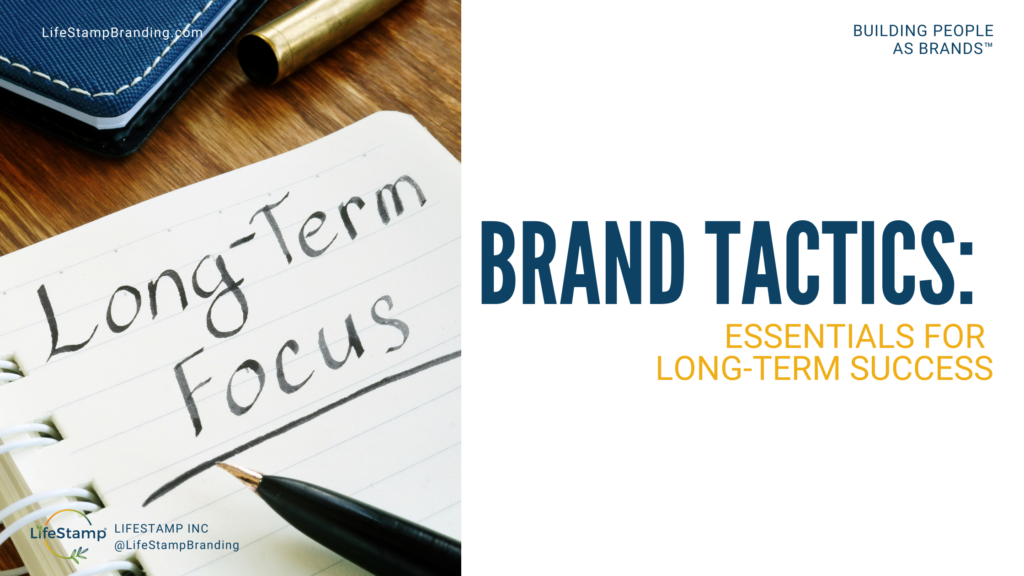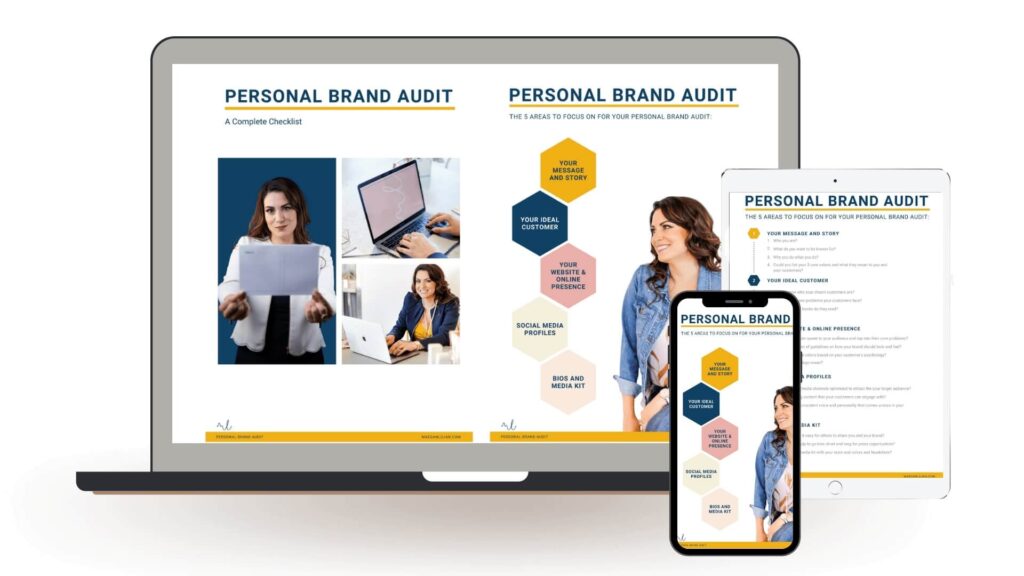
If you are starting to map out your personal brand strategy here are four tactics that need to be uncovered before you begin:
- Foundation Setting
- Target Audience
- Content Strategy, and
- Brand Identity
Why?
Because the more detailed you are with your personal branding tactics, the easier it will be to succeed when you execute those tactics.
But how does one get there?
In a previous article, I took you on a deep dive into the path to building a strong personal brand. If you are new to the blog, or just getting started building your brand, I recommend you start reading there to gain clarity around the vision you have for your brand. It is an important step you do not want to miss.
In a follow-up article, I also discussed the importance of building your thought leadership brand story.
This piece is a must-read for taking control of the brand story you put into this world and how important it is to be the author of how your story is told.
Personal brands matter
People do not do business with companies. Rather, people seek to do business with others they like.
Whether that is relationships built on trust or mutual connections, there is just something about working with another human being you like that creates a level of endearment and customer loyalty beyond any relationship a company could achieve.
The strong bonds people have with one another cannot be overestimated. This is true even with large companies that are household names.
Even big companies, like Apple, Tesla, and Virgin have people whose personalities serve to advance their brand’s mission. Otherwise, would we know that Steve Jobs, Elon Musk, or Richard Branson even exist?
If you are a small business owner or entrepreneur, then this personality is you. If you are part of a team in the marketing department, perhaps it is one of the executives.
However, even if you work for a large organization as an employee, there is no reason why you should not build your own personal brand.
By putting yourself out there and allowing your thoughts to be known, people will start listening to you—and by default, your company—as a thought leader. The power of the human connection you are then making can potentially lead to more opportunities for both you and your company.
Branding in the digital world
While the digital world gives us an amazing opportunity to create human interactions and multiply them at scale, it does not even come close to the connection one feels with having coffee in person or getting to know someone face to face. The digital networking world does, however, allow for a one-way broadcast that lets people feel like they know you.
A bridge that connects you to people globally and impacts your brand engagement, target market, and instantly links with your audience, a digital community is more essential than ever.
Designing your identity
For your personal brand to be ready to be released in the digital world, you first need to build out your brand identity and put together your brand guidelines.
Identifying your brand identity before you start clicking away and updating your digital footprint is vital. Remember, your vision and mission must be in alignment for you to have clear brand visuals that resonate with your target audience.
Before you start building and promoting your personal brand online, you first need to pull everything together and create your comprehensive brand identity. There are plenty of tactics you can implement to boost your brand; a powerful design will be the first starting point.
Perform a brand audit
Is your branding consistent across all physical and digital platforms? Before you can start shaping out your visuals, I highly recommend you do a quick brand audit. Especially of your digital footprint.
A brand audit is a thorough examination of your personal brand’s current position in the market compared to its competitors and a review of its effectiveness.
This audit helps you determine the strength of your personal brand together with its weaknesses or inconsistencies, as well as the opportunities for improvement and new developments.
The stronger your personal brand, the more powerful it will be.
A powerful brand can inspire, captivate, and engage your audience and consequently increase your bottom line. However, even strong brands need a check-in from time to time to keep them on track.
A robust, consistent personal brand means you spend less money on attracting new customers. It also means your current customers keep returning to you, which allows you to charge a premium price for your goods and/or services.
A powerful brand also encourages referrals, both online and offline, and are a critical part of the brand and its profitability.
That said, a weak, disconnected, out of touch personal brand will gradually see its market shrink, sales decline, and ultimately be out of business.
A comprehensive brand audit will often reveal new growth opportunities for your personal brand, as well as new ways to make your brand resonate with both existing and new customers.
If you are not sure where to get started, I recommend beginning your brand audit by asking yourself the following questions:
- Is your personal brand properly represented by…
- Your profile picture?
- Your title?
- Your bio?
- Your cover image (if applicable)?
- Is your profile page informative?
- Do people understand who you are and what you stand for?
- Do you have an overall visual theme that fits well with your brand?
- Are your images, video, and graphics all high-quality?
- Are you posting new content consistently?
- Are you sharing valuable plus relevant content?
- Do you have an overall theme that fits well with your branding?
- Do you have links to your website and other social media accounts visible?
Using the questions above, go through your digital footprint and remove—or make private—any parts of your life that are no longer accurate or relevant to your current objectives. Then, focus on bringing forward the parts of you that you want to highlight front and center as part of your personal brand.
DOWNLOAD THE PERSONAL BRAND AUDIT CHECKLIST
Design your brand visuals
Once you finalize your personal brand and perform your brand audit, it is time to think about how you will deliver your message.
This is where you will start to get creative with things like the logo design, the fonts you use on your website or in Canva, the colors you choose to represent your brand, the general tone of your advertisements, the imagery you use to convey your messaging, and more. These visual elements are very important for creating a long-term recognizable personal brand.
Once people have connected to your brand, they are no longer considering your values because they know them. Now, they are recognizing your brand’s colors, logo, and font and instantly adding you to their shopping cart. For this reason, you need to ensure that your visual brand elements are consistent.
While I realize that all personal brands do evolve over time, it is still very important to set the creative guidelines for your personal brand before executing any marketing or promotional tactics.
Having a solid strategy in place for your brand visuals allows you to ensure that even in the future, your branding always will match your story.
Building your brand
Brand book, style guide, brand guidelines. No matter how you refer to it, this resource is the heart and soul of your personal brand.
This document is one of the most important steps in the building process for your personal brand, and it takes your mission, vision, and values, and translates them into visual design.
Your brand book also establishes strict guidelines on every aspect of how your personal brand will be managed.
A well-developed, comprehensive brand book will help everyone who interacts with your brand on your behalf know exactly how to communicate and visually present your brand.
From how your logo can be used to the look of your website to how social media is brought into the fold, when advertising takes place, how to design products, and so on.
At its heart, a basic brand book should include the following:
- An overview of brand values, the core promise, the drivers, and persona
- Logo specifications and examples of how to use it
- Logo lockups for different uses
- Color palette
- Font styles and typography
- Image and photography guidelines
- Writing style and tone of voice
- Brochure guidelines
- Specifications for signage and outdoor advertising
- Design layouts for print and web-based projects
- Store designs and build-outs
- Social media guidelines
- Letterhead and business card design
A brand book is a living document that will evolve over time. For this reason, I recommend you revisit yours periodically so it can be reviewed and refreshed, if necessary.
Whether that is once a quarter or annually, the timeline is up to you.
For reference, I update my brand book whenever I launch a new website, product, or marketing campaign.
Want to learn more about how to implement the best tactics for your brand?
Get easy to follow, and every easier to implement, steps by clicking here.


